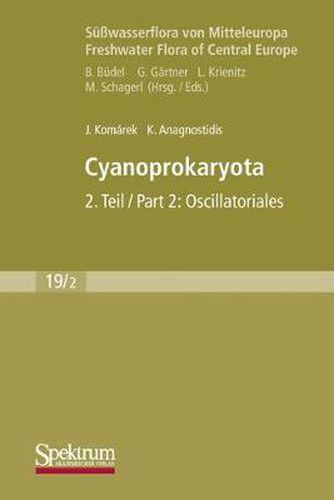Susswasserflora von Mitteleuropa, Bd. 19/2: Cyanoprokaryota: Bd. 2 / Part 2: Oscillatoriales
Jiri Komarek,Konstantinos Anagnostidis,Johannes Gerloff,Adolf Pascher,Jiri Komarek

Susswasserflora von Mitteleuropa, Bd. 19/2: Cyanoprokaryota: Bd. 2 / Part 2: Oscillatoriales
Jiri Komarek,Konstantinos Anagnostidis,Johannes Gerloff,Adolf Pascher,Jiri Komarek
Cyanoprokaryotes are probably the oldest organisms with plant metabolism. However, their cell structure and type of asexual reproduction prove their eubacterial origin. In spite of their existence from Precambrian onwards they have not lost their vitality, and still are able to colonize all possible biotopes, including very extreme environments (thermal springs up to 80 DegreesC, rocks in extremely hot or cold deserts in both the tropics and Antarctica, hypersaline lakes and marshes, biotopes in volcanic regions, and other harsh habitats).
This book is a review of all the cyanoprokaryotic taxonomic units, registered and recognizable from European natural biotopes, including the marine coasts. Our determination keys and taxonomic descriptions should permit the identification of natural populations, and should be related to known culture material. Numerous strains were isolated, kept in strain collections and used as important model organisms for experiments of various kinds. In culture only a few cyanoprokaryotes show the typical growth form known from nature, most others can be made to display their typical forms and life cycles by special procedures only. The identification of strains without previous knowledge of natural material needs to be carried out with special care.
The aim of this book is to make possible the identification and standardization of known, morphologically and ecologically distinguishable cyanoprokaryotes that have been described from natural populations in Europe. Therefore, in the introductory part only data important for identification are presented. At the end of this chapter we append a list of basic literature, where all the detailed information necessary can be found. We have selected accurate drawings of the species described in the text. We also present illustrations of some non-European species if necessary for understanding the generic diacritical features or infrageneric diversity.
This item is not currently in-stock. It can be ordered online and is expected to ship in approx 4 weeks
Our stock data is updated periodically, and availability may change throughout the day for in-demand items. Please call the relevant shop for the most current stock information. Prices are subject to change without notice.
Sign in or become a Readings Member to add this title to a wishlist.


